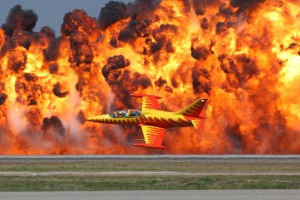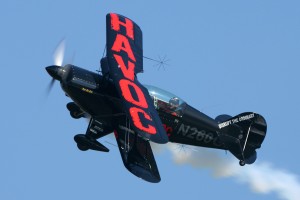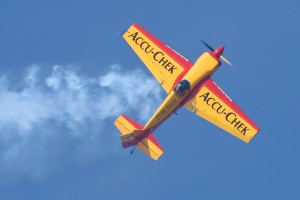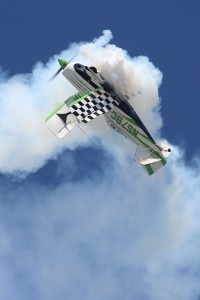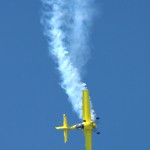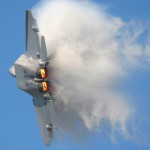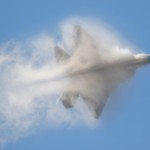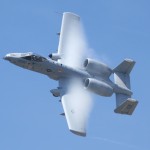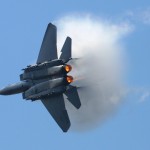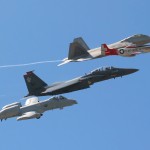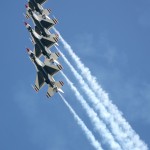By Victor G. Archer
The highlight of this year’s NAS Point Mugu air show was to be the Air Force flight demonstration team, the Thunderbirds, flying the combat proven F-16 Fighting Falcons but judging by the crowd’s reaction, the F/A-22 Raptor stole the show.
This was the first time an F/A-22 Raptor had flown in the Point Mugu air show. The Air Force brought its demonstration team. While the full demonstration won’t be seen until next year, with full afterburning muscle climbs and high G turns, Maj. Paul “Max” Moga gave the crowd a good idea of its capabilities. Moga is the only Raptor pilot qualified to fly public aerial demonstration maneuvers.
Also for the first time ever, the Raptor made a couple of passes with all the weapons bays open. With the very humid weather conditions, the Raptor almost disappeared into a cloud of vapor every time it made a high speed pass or a tight high G turn. It was an amazing sight, almost as if the jet carried its own cloud around with it.
The civilian acts in the show included Spencer Studerman in his Pitts S2-B biplane, Havoc, and Bill Cornick, who returned once again to thrill air show spectators at Point Mugu. He flew his custom designed Pitts S-2C, Big Bad Green, through a series of inverted flat spins, multiple snap rolls and torque rolls.
Michael Hunter flew the Flight for Diabetes, a Laser 230. This was his second appearance at Point Mugu, and he put on a great demonstration. The Flight for Diabetes, Inc. is a nonprofit corporation founded to increase public awareness and educational programs for children with diabetes.
Rob Harrison, the “Tumbling Bear,” was another returning aerobatic pilot. Harrison, flying his bright yellow Zlin 50LX, put on a great performance. When he flips and tumbles his airplane through the air, it’s easy to understand the nickname.
The highlight of the civil performances had to be when Rich Perkins made a low level pass directly in front of a huge wall of fire in the Firecat, his Aero Vodochody L-39 jet. He also put on an aerobatic display, showing the maneuverability of the L-39. Perkins is a very accomplished pilot and has flown more than 70 different aircraft, including everything from a C-130 to an ultra high-flying U-2 spy plane.
The crowd enjoyed several military demonstrations, along with the amazing performance of the F/A-22 Raptor flown by Moga. Moga also flew in the Heritage Flight with Capt. Al Kennedy and Capt. Jack Stallworth in the F-15E Strike Eagle and Maj. Brian Willits in the A-10 Thunderbolt II. The Heritage Flight also included a P-51D Mustang, flown by Apollo astronaut Bill Anders, and the A-10 and F-15E performed individual demonstrations.
The F-15E Strike Eagle, flown by Kennedy and Stallworth, went through its paces, with several maneuvers including a knife edge pass, full afterburning vertical climb, high G turns and mock ground attacks. The Strike Eagle is a dual-role fighter, designed to perform air-to-air and air-to-ground missions. An array of avionics and electronics systems gives the F-15E the capability to fight at low altitude, day or night, and in all weather.
Willits put on a great demonstration in the A-10A. The A-10 was designed for the Air Force, to provide day and night close-air combat support for friendly land forces. The simple, effective and highly survivable twin-engine jet aircraft can be used against all ground targets, including tanks and other armored vehicles.
The C-130J Super Hercules, from the Channel Islands Air National Guard 146th Airlift Group/115 Airlift Squadron, made a few flybys and demonstrated its short takeoff and landing capabilities. The transport aircraft is capable of flying higher, farther and faster than previous C-130 models, while carrying more cargo.
The 49th Fighter Wing’s Black Sheep Squadron, based at Holloman Air Force Base, N.M., brought a pair of F-117A Nighthawk Stealth Fighters. One was on static display, and the other made a few passes for the crowd. The world’s first operational stealth fighter aircraft went into service in 1992 and will retire in 2008. This may have been its final air show appearance in Southern California.
A temporary grounding of the FA-18 Super Hornet for inspection led to a cancellation of the scheduled flight demonstration by the Flying Eagles (VFA-122).
This year marks the Thunderbirds’ 60th anniversary. They closed out the show with precision flying. From their six-aircraft Delta formation to the opposing solos, the Thunderbirds always thrill the crowd. This year, for the first time, two female pilots are flying in the group: Maj. Nicole Malachowski, Thunderbird # 3, is on right wing, and Maj. Samantha Weeks, # 6, is in the opposing solo position.
The air show was well-organized, guests enjoyed easy access on and off the base and a lot of aircraft were on display, with some offering walk-through tours. Vendors offered refreshments, and two play areas and a carnival brought extra enjoyment for the children.
It’s a great show in a unique location, usually with near-perfect weather. This is an air show that should be on your list to attend next year.
- Rob Harrison, the “Tumbling Bear,” flies his Zlin 50LX
- Maj. Paul “Max” Moga and the F/A-22 Raptor are pulling lots of Gs.
- Looking more like a stingray under water, Maj. Paul “Max” Moga takes the Raptor through a near right angle turn.
- While making a high speed pass, the F/A-22 Raptor almost completely disappears in its own vapor cloud.
- A C-130J Super Hercules from the Channel Islands Air National Guard makes a flyby.
- An F-117A Nighthawk Stealth Fighter creates its own stealth cloud.
- The A-10A Thunderbolt II makes a mock attack on the field.
- Capt. Al Kennedy and Capt. Jack Stallworth pull heavy Gs in the F-15E Strike Eagle.
- The USAF Heritage Flight featured, top to bottom, an F/A-22 Raptor, P-51 Mustang, F-15E Strike Eagle and A-10 Thunderbolt II.
- The Thunderbirds fly in a four-ship diamond, their signature formation.
- The Thunderbirds climb straight up in perfect formation.












